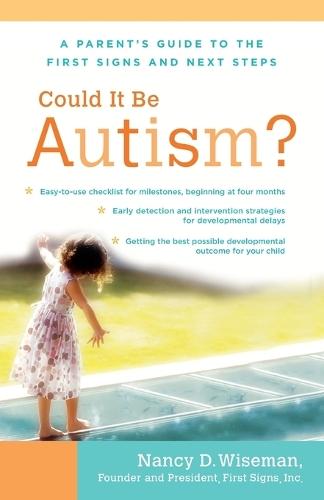Full Product Details
Author: Nancy Wiseman ,
Kim Painter Koffsky
Publisher: Potter/Ten Speed/Harmony/Rodale
Imprint: Harmony Books
Dimensions:
Width: 13.20cm
, Height: 1.50cm
, Length: 20.30cm
Weight: 0.213kg
ISBN: 9780767919739
ISBN 10: 0767919734
Pages: 272
Publication Date: 10 April 2007
Audience:
General/trade
,
General
Format: Paperback
Publisher's Status: Inactive
Availability: In Print

Limited stock is available. It will be ordered for you and shipped pending supplier's limited stock.
Reviews
This is a very-well-written, informative, and, at the same time, hopeful book from which both parents and professionals will learn. I can't wait to recommend it to the families we see. -- Catherine Lord, Ph.D., Director, University of Michigan Autism and Communication Disorders Center (UMACC) <br> <br> Nancy Wiseman provides detailed steps of everything parents need to do from the moment they suspect their child may be delayed. I wish I had this book when my grandson was diagnosed with autism. This book is a gift to parents and grandparents who find themselves on the autism road but need a map. -- Suzanne Wright, cofounder, Autism Speaks<br> <br> I wish I' d had this book when I needed it. Reading Could It Be Autism? may help parents identify at-risk children and start intervention early enough to possibly slow or halt the development of autism. This book is a potential lifesaver. -- Christina Adams, <br>author of A Real Boy: A True Story of Autism, Early Intervention and Recovery <br> Nancy Wiseman's gem of a book is so surprising in that there is not one paragraph that does not inform, clarify, and reassure. The author is like an expert friend, several steps ahead, who never fails to turns around, gently leading parents where they need to go. This book reduces the heartbreak, offers hope, and empowers parents so they can provide optimal and timely treatment for their child. -- Demitri F. Papolos, M.D., and Janice Papolos, coauthors of The Bipolar Child
This is a very-well-written, informative, and, at the same time, hopeful book from which both parents and professionals will learn. I can't wait to recommend it to the families we see. -- Catherine Lord, Ph.D., Director, University of Michigan Autism and Communication Disorders Center (UMACC) <br> <br><br> Nancy Wiseman provides detailed steps of everything parents need to do from the moment they suspect their child may be delayed. I wish I had this book when my grandson was diagnosed with autism. This book is a gift to parents and grandparents who find themselves on the autism road but need a map. -- Suzanne Wright, cofounder, Autism Speaks<br> <br> I wish I'd had this book when I needed it. Reading Could It Be Autism? may help parents identify at-risk children and start intervention early enough to possibly slow or halt the development of autism. This book is a potential lifesaver. -- Christina Adams, <br>author of A Real Boy: A True Story of Autism, Early Intervention and Recovery <br><br> Nancy Wiseman's gem of a book is so surprising in that there is not one paragraph that does not inform, clarify, and reassure. The author is like an expert friend, several steps ahead, who never fails to turns around, gently leading parents where they need to go. This book reduces the heartbreak, offers hope, and empowers parents so they can provide optimal and timely treatment for their child. -- Demitri F. Papolos, M.D., and Janice Papolos, coauthors of The Bipolar Child
Author Information
Nancy Wiseman is the founder and president of First Signs, Inc., a national nonprofit organization dedicated to educating parents and pediatric professionals about the early warning signs of autism and other developmental disorders. First Signs provides professionals with tools and training and parents with education and support to help young children stay on a healthy developmental path. Nancy is the mother of Sarah, who was diagnosed with autism at the age of two. Today—at age nine—Sarah stands as a powerful and positive example of the impact that early identification and intensive intervention can have on young children with developmental delays and disorders. This little girl, once so profoundly delayed, has made remarkable progress, much like the organization she inspired seven years ago.



